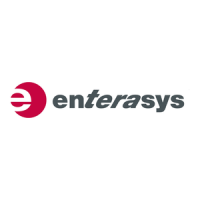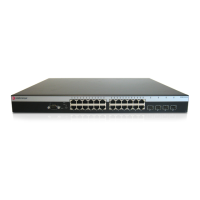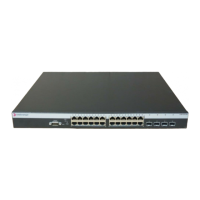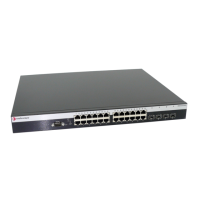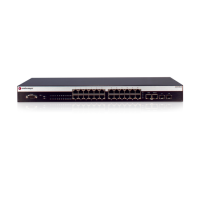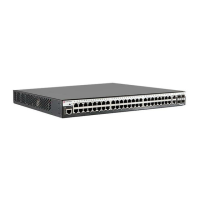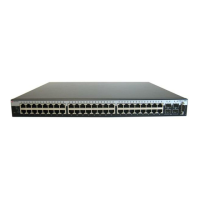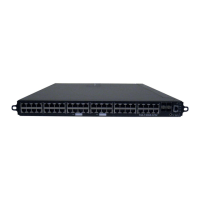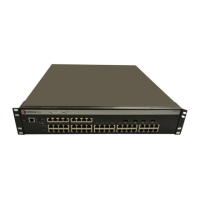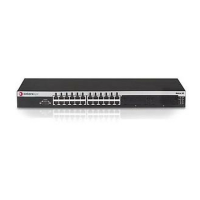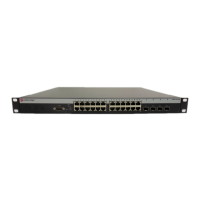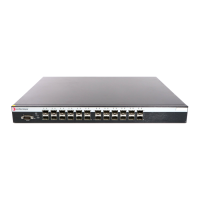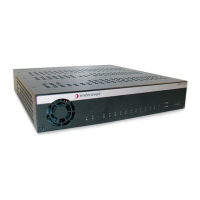
Do you have a question about the Enterasys D-Series and is the answer not in the manual?
| Dimensions | Varies by model |
|---|---|
| Switching Capacity | Varies by model |
| Forwarding Rate | Varies by model |
| MAC Address Table Size | Varies by model |
| Weight | Varies by model |
| Ports | Varies by model |
| Uplink Ports | Varies by model |
| Power over Ethernet (PoE) | Varies by model |
| Layer | Varies by model |
| Management | Varies by model |
| Power Supply | Varies by model |
| PoE Support | Varies by model |
| VLANs | Varies by model |
| Jumbo Frame Support | Varies by model |
| Operating Temperature | Varies by model |
| Storage Temperature | Varies by model |
| Humidity | Varies by model |
Explains how to access the device's Command Line Interface (CLI) and perform network management operations.
Outlines the organization of the manual into chapters covering CLI, basic configuration, licensed features, and more.
Provides contact information and methods for obtaining additional support for the switch or its documentation.
Provides an overview of tasks performable via the CLI, including network management and configuration operations.
Details various methods for managing the D-Series switch, including console, modem, SNMP, and Telnet connections.
Lists the default settings for basic switch operation, covering protocols, ports, security, and system parameters.
Explains how to start a CLI session via console or Telnet and navigate the interface using commands and help.
Provides a quick reference for essential CLI commands needed for initial D2 switch operation and firmware setup.
Explains how to manage user login accounts and passwords, including adding new accounts and changing defaults.
Covers displaying and setting fundamental system properties like IP address, system name, location, and contact information.
Details commands for displaying, applying, and clearing D-Series licensed features after purchase.
Displays system power properties, including available power and usage thresholds for modules.
Explains how to review and configure the Enterasys CDP discovery protocol for network topology discovery.
Details how to review and configure the Cisco discovery protocol for network topology and phone detection.
Covers LLDP and LLDP-MED configuration for advertising device identities and capabilities on a network.
Provides an overview of port configuration, including port string syntax and SFP port setup.
Explains the syntax used for designating port type, slot location, and port number in CLI commands.
Details the steps to configure SFP ports for 100BASE-FX connections using Fast Ethernet transceivers.
Explains how to display operating status, duplex mode, speed, port type, and traffic statistics for switch ports.
Covers disabling/enabling ports for security or troubleshooting, and assigning aliases for convenience.
Explains how to review and set operational speed in Mbps and default duplex mode for ports.
Details how to enable and disable jumbo frame support on ports, allowing Gigabit Ethernet to transmit larger frames.
Explains how to review, disable, or enable auto-negotiation and configure port advertisement for speed and duplex.
Describes how to review, enable, or disable port flow control to manage transmission and prevent port overload.
Covers disabling/enabling link traps, displaying status, and configuring link flapping detection.
Explains how to review and set broadcast suppression thresholds per port to limit broadcast frames.
Details how to mirror or redirect traffic on a port for network analysis and connection assurance.
Explains LACP, which logically groups interfaces to create greater bandwidth uplinks or link aggregations.
Provides an overview of SNMP, its versions (v1, v2c, v3), and its role in network management.
Describes the components of SNMPv1 and SNMPv2c network management, including managed devices and agents.
Explains SNMPv3 as a secure protocol providing access by authenticating and encrypting frames.
Defines SNMP security models and levels (NoAuthNoPriv, AuthNoPriv, authPriv) for user authentication.
Explains how to use SNMP contexts to limit access to specific MIB objects via user groups.
Describes how to review SNMP statistics, including engine ID, boots, time, and maximum message size.
Details how to configure SNMP users, groups, and communities for SNMPv1, v2c, and v3 management.
Explains how to configure SNMP access rights, assigning privileges and security levels to SNMP user groups.
Describes how to configure SNMP MIB views to map SNMP objects to access rights.
Covers configuring SNMP target parameters that control where and under what circumstances SNMP notifications are sent.
Explains how to configure SNMP target addresses that will receive SNMP notification messages.
Details how to configure SNMP notification parameters and optional filters to manage notification targets.
Provides an overview of STP, RSTP, and MSTP protocols and their functions in network topology.
Explains IEEE 802.1D STP, 802.1w RSTP, and 802.1s MSTP protocols for loop prevention.
Details the D-Series device's Spanning Tree Protocol functions for creating, compensating, and managing topology.
Describes the Loop Protect feature which prevents or short circuits loop formation in networks with redundant paths.
Covers displaying and setting Spanning Tree bridge parameters like priority, hello time, and forward delay.
Explains how to display and set Spanning Tree port parameters, including admin status and priority.
Details setting Spanning Tree Loop Protect parameters like threshold, window, and traps.
Provides an overview of Virtual LANs, their role in partitioning traffic, and GVRP configuration.
Explains the syntax used for designating VLANs and port numbers in CLI commands.
Guides on creating a management-only VLAN for secure device access, ensuring only select devices can manage the switch.
Describes how to display configured VLANs, port assignments, and traffic transmission modes.
Details the process of creating new static VLANs and assigning names to existing or new VLANs.
Explains assigning default VLAN IDs to untagged frames, configuring ingress filtering, and setting frame discard mode.
Covers assigning or removing ports from a VLAN egress list to determine frame transmission eligibility.
Describes configuring a host VLAN for secure management access, allowing only select devices access.
Explains GVRP's purpose in dynamically creating VLANs and how it propagates VLAN information across a network.
Explains how to globally enable or disable the Diffserv feature on the device.
Details reviewing, creating, and configuring Diffserv classes and matching conditions for packet classification.
Covers reviewing, creating, and configuring Diffserv policies and assigning classes to them.
Explains how to review and assign Diffserv policies and their associated classes to service ports.
Provides examples of DiffServ policy creation, including rate limiting and DSCP marking.
Overview of D-Series policy profile-based provisioning for network resources, including creating and assigning rules.
Details creating, changing, and removing user profiles for managing network resources based on business policies.
Explains how to review, create, assign, and unassign classification rules to policy profiles for frame filtering.
Covers assigning and unassigning ports to policy profiles, ensuring only activated ports transmit frames.
Details assigning mission-critical data higher priority by defining CoS settings and rate limiters.
Overview of port priority characteristics, including default CoS transmit priority and traffic mapping.
Explains how to display or change the default Class-of-Service (CoS) transmit priority for frames.
Details how to view and configure priority to transmit queue mapping for physical ports.
Covers setting priority mode and weight for transmit queues on each port, implementing QoS.
Explains how to limit the rate of inbound traffic on a per port/priority basis to prevent congestion.
Provides an overview of IGMP, IP multicast group management, and multicasting principles.
Details how to configure IGMP snooping from the switch CLI for efficient multicast traffic forwarding.
Explains how to configure system logging, including Syslog server settings, defaults, and logging buffer.
Covers displaying switch events and command history, setting history buffer size, and managing user sessions.
Details displaying or deleting switch ARP table entries and displaying MAC address information.
Explains how to configure SNTP to synchronize device clocks in a network.
Covers reviewing, disabling, and re-enabling node alias functionality for ports.
Overview of RMON groups for network fault diagnosis, planning, and performance tuning.
Details commands for displaying, configuring, and clearing RMON statistics.
Covers commands for displaying, configuring, and clearing RMON history properties and statistics.
Details commands for displaying, configuring, and clearing RMON alarm entries and properties.
Covers commands to display and clear RMON events, and configure RMON event properties.
Details commands for displaying RMON channel and filter entries, and configuring filters.
Covers commands to display, configure, enable, disable, and clear RMON capture entries.
Provides an overview of DHCP for IPv4, its role in IP address assignment, and relay agents.
Explains DHCP server functionality for providing IP configuration and its mechanisms for IP address allocation.
Details configuring DHCP server parameters, including enabling/disabling the server and conflict logging.
Covers configuring and clearing DHCP address pool parameters for dynamic and static IP assignments.
Describes available security methods for controlling user access, including login accounts, HACA, and SNMP.
Explains using RADIUS Filter-ID to dynamically assign policy profiles and management levels to users.
Details reviewing, enabling/disabling RADIUS client/server, and setting server parameters.
Covers reviewing and configuring 802.1X authentication for ports using EAPOL for user authorization.
Explains reviewing, enabling, disabling, and configuring MAC authentication for source MAC addresses.
Details how to enable multiple authentication types per port, including User + IP phone authentication.
Explains RFC 3580 Tunnel Attributes for containing authenticated users to a VLAN based on RADIUS results.
Covers reviewing, disabling, enabling, and configuring MAC locking to prevent unauthorized devices on ports.
Details how to review, enable, disable, and configure Port Web Authentication (PWA) for user access.
Explains how to review, enable, disable, and configure Secure Shell (SSH) protocol for secure Telnet.
